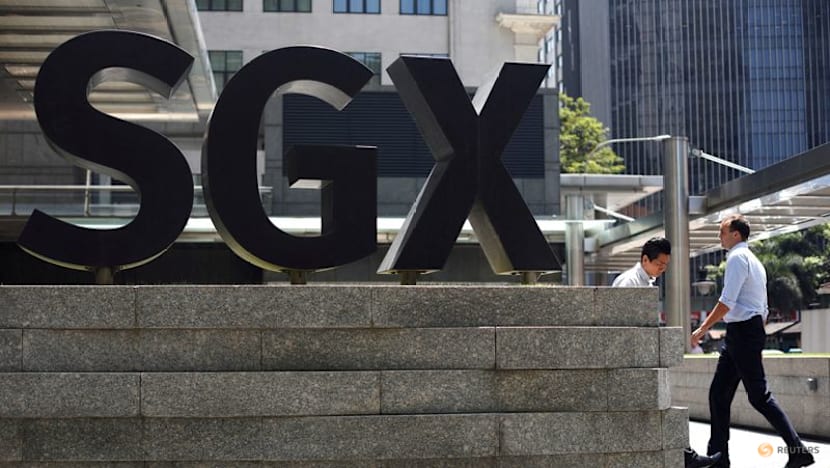Commentary: Singapore’s stock market is no longer just about the big boys
For investors who have looked past Singapore’s market in favour of regional plays, the message is that the winds are changing, says former editor and financial journalist Ven Sreenivasan.

File photo of the Singapore Stock Exchange. (Photo: Reuters/Edgar Su)

This audio is generated by an AI tool.
SINGAPORE: After a decade of sluggish performance, Singapore’s stock market suddenly feels alive again.
After falling to a 52-week low in April amid concerns over tariffs and global economic uncertainty, the Straits Times Index (STI) surged to a record high of 4,375 on Friday (Sep 12), pulling off a 29 per cent rebound in just five months.
Much of the focus has been on the usual suspects - DBS, UOB, OCBC and Singtel - which together dominate nearly half the STI.
While these blue-chip counters continue to matter, of course, attention is starting to shift toward the rest of the market. That shift could very well pick up pace with the proposed launch of a new equity index to track companies that are not part of the STI.
Announced by National Development Minister and Monetary Authority of Singapore (MAS) Deputy Chairman Chee Hong Tat on Friday, Mr Chee said the new index will help investors follow how “the next tier of large and liquid companies” are evolving, be it through business model transformation, improved governance or strengthening their capital management.
This is a timely measure that recognises that the Singapore bourse comprises more than just the banks and conglomerates.
Indeed, the 30 components of the marquee Singapore index represent barely 5 per cent of the over 600 names listed on the Singapore Exchange.
Why this new index had not been thought of earlier remains a mystery.
But why it has become relevant now is obvious.
A WIDER MARKET SHIFT
What makes the Singapore story particularly compelling is the breadth of the upswing. For years, investors lamented the stagnation of mid-caps and second liners. But now, these long-neglected counters are showing fresh signs of life.
The likes of engineering and technology group Boustead, real estate management firm LHN, accommodation provider Centurion, construction firm Wee Hur, design and production group Kingsmen and dozens of others are at decades, if not record, highs. And the tide continues to lift more boats.
In fact, since the second quarter of this year, activity on the Singapore bourse has been dominated by mid-caps and second liners.
Of course, all this has happened as US equities are scaling new peaks, with both the S&P 500 and Nasdaq closing at record highs. The optimism has spilled across the Pacific, pushing the MSCI Asia index toward its own summit.
For the second liners in Singapore, the turnaround also owes much to the MAS’ Equity Market Development Programme. Of the S$5 billion earmarked to revive the market, some S$1 billion has already been allocated across three funds tasked with breathing new energy into these stocks.
Momentum could build further, especially if the launch of this new “broader” mid-cap market index turbocharges this segment by drawing more institutional money and creating room for new passive ETF tracker funds.
COMPANIES NEED TO SHOW UP FOR INVESTORS TOO
But building a new index, as critical as it is to recognise the performance of second liners, is only part of the story.
As Mr Chee pointed out during his speech at a Singapore Institute of Directors conference, companies themselves have to proactively engage shareholders and the investing public at large.
This means regular and active investor engagement that goes beyond annual or half-yearly earnings briefings. In short, senior company officials need to communicate more consistently and clearly and make their business activities more visible to the market. Done well, this will boost investor interest, spark liquidity and even engage institutional investors who for so long have focused on the bourse’s “big boys”.
But there may also be a need to re-examine the existing disclosure regime. Companies need some guidance on continuous disclosure, especially pertaining to sensitive forward-looking statements. This is because company officials may worry about regulatory or litigation risks of saying too much. So there may be a need to create a "safe harbour" for routine forward-looking disclosures.
Such strategic outreach will deliver more benefits than just stock price support. Besides enhancing shareholder value, it will, in time, also lower the cost of capital for these companies as they raise funds to propel their growth. Instead of turning to borrowings, they can fund their growth via the placement of shares which will find willing subscribers in the broader market, and especially amongst institutional investors.
In short, it creates a virtuous circle.
In the wake of global uncertainties and geopolitical turmoil, a lot of funds have flowed into “safe” Singapore in recent years, and especially into its wealth markets. Some of these funds are now seeking higher returns in equities as interest rates look set to decline.
For investors who have long looked past Singapore’s market in favour of regional plays, the message is that the winds are changing. And this time they’re blowing in Singapore’s favour.
If the US economy stays resilient and global markets avoid shocks, local equities could be heading toward their strongest year in more than 10 years.
Ven Sreenivasan is a former editor and journalist who has covered financial markets, economic and corporate news and aviation for more than 30 years.

















